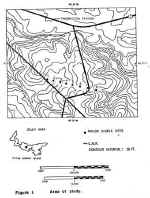|
1976.
M.Sc., 121 pp.
SURFICIAL
DEPOSITS IN CENTRAL PRINCE EDWARD ISLAND: THEIR ORIGIN AND SOIL GENESIS
MacLean, B.
 The retreat of the
continental glaciers from Central Prince Edward Island left a landscape
characterized by highly variable deposits.
These deposits have previously been mapped as weathered bedrock and glacial
till. This thesis examined these deposits and attempted to determine their
origins more precisely. Eight sites
were selected and each deposit was fully described in the field, and when
necessary, studies on particle size distribution, stone shape and roundness,
stone orientation and imbrication and micromorphology were conducted. Initial
field investigations revealed the complex nature of the surficial deposits. Most
of the deposits located on the higher e1evations were either sandy and loose,
or formed on dense clay rich material. Stone orientation and imbrication
analysis revealed that many of the deposits had been moved down- slope,
indicating either solifluction or soil creep. The analysis of the particle size
distributions of the surficial material and the unconsolidated bedrock samples
differentiated between deposits that had
weathered in situ and deposits that had been transported. However, it could not
differentiate between basal till, ablation till or material that had moved
either by solifluction or soil creep. Stone shape and roundness analysis proved
to be more effective in separating these deposits. Deposits formed as basal till
contained more spherical shaped stones with low roundness, while the stones in
ablation till were also spherical but had higher roundness values. From stone
shape and roundness analysis it was not possible to deter- mine those deposits
that had undergone solifluction or soil creep, since the effect of these
processes on pebble geometry is not known. Soil micromorphology analysis was conducted on only two
profiles. The process of in situ weathering was evident in one of the profiles,
confirming the findings of the other analysis.
Soil texture was found to be a dominant factor affecting the genesis of
the soil. In loose, coarse textured soils, translocation of Fe and AI was the
dominant process, while in the compact fine textured soils, clay translocation
was also important. The coarse , textured soils were classified as Orthic Rumo-Ferric
Podzols, while the fine textured soils were classified as Brunisolic Gray Brown
Luvisols or Podzolic Gray Brown Luvisols. The retreat of the
continental glaciers from Central Prince Edward Island left a landscape
characterized by highly variable deposits.
These deposits have previously been mapped as weathered bedrock and glacial
till. This thesis examined these deposits and attempted to determine their
origins more precisely. Eight sites
were selected and each deposit was fully described in the field, and when
necessary, studies on particle size distribution, stone shape and roundness,
stone orientation and imbrication and micromorphology were conducted. Initial
field investigations revealed the complex nature of the surficial deposits. Most
of the deposits located on the higher e1evations were either sandy and loose,
or formed on dense clay rich material. Stone orientation and imbrication
analysis revealed that many of the deposits had been moved down- slope,
indicating either solifluction or soil creep. The analysis of the particle size
distributions of the surficial material and the unconsolidated bedrock samples
differentiated between deposits that had
weathered in situ and deposits that had been transported. However, it could not
differentiate between basal till, ablation till or material that had moved
either by solifluction or soil creep. Stone shape and roundness analysis proved
to be more effective in separating these deposits. Deposits formed as basal till
contained more spherical shaped stones with low roundness, while the stones in
ablation till were also spherical but had higher roundness values. From stone
shape and roundness analysis it was not possible to deter- mine those deposits
that had undergone solifluction or soil creep, since the effect of these
processes on pebble geometry is not known. Soil micromorphology analysis was conducted on only two
profiles. The process of in situ weathering was evident in one of the profiles,
confirming the findings of the other analysis.
Soil texture was found to be a dominant factor affecting the genesis of
the soil. In loose, coarse textured soils, translocation of Fe and AI was the
dominant process, while in the compact fine textured soils, clay translocation
was also important. The coarse , textured soils were classified as Orthic Rumo-Ferric
Podzols, while the fine textured soils were classified as Brunisolic Gray Brown
Luvisols or Podzolic Gray Brown Luvisols.
|